Tracking Microplastics From Sea To Body
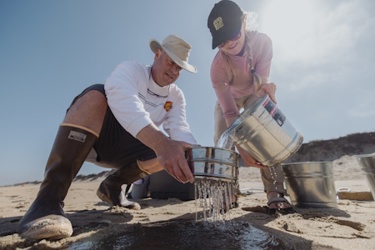
Stanford researchers are uncovering the journey of microplastics in our environment and their effects on human health, while developing practical solutions to mitigate their impact.
On the edge of California’s Monterey Bay, ecologist Matthew Savoca and a team of volunteers sift through sand and seawater for microplastics, one of the planet’s most pervasive forms of pollution.
Originating in everyday items, these bits of plastic smaller than a sesame seed turn up just about everywhere researchers have looked – including in our own bodies and in habitats from alpine mountains to the deep ocean. Along the high-tide line of Carmel River State Beach, Savoca’s team finds them washed up by the bay’s lapping waves.
“We know there are hundreds of trillions of microplastic particles in the world,” said Savoca, a research scientist at the Stanford Doerr School of Sustainability’s Hopkins Marine Station, about eight miles north of the field site. But questions about how microplastics disperse, for how long, and where they come to rest remain unresolved.
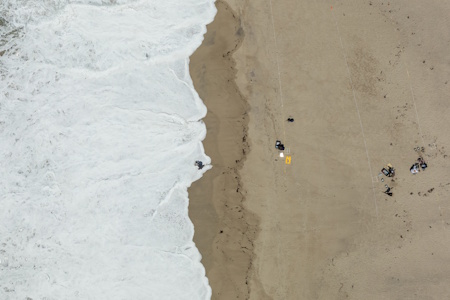
Savoca is among a growing cadre of researchers at Stanford and beyond – from Earth system scientists, marine biologists, and oceanographers to physicians and engineers – who are working to answer them. “Knowing where microplastics end up is vital to understand the risk they pose to species and the ecosystem at large,” Savoca said.
Searching for clues in the ‘blue Serengeti’
Monterey Bay offers an ideal setting to understand how plastic pollution flows through the marine environment. Just beyond the break in the continental shelf, where krill and blue whales congregate, deep sea zones abut kelp forests and intertidal zones. Across this rich habitat, sometimes compared to the Serengeti for its biological diversity, decades of monitoring data provide context to understand microplastics that show up in surveys.
Savoca and collaborators have collected samples not only from beaches but also coastal waters, four rivers that feed into the Monterey Bay, and wildlife, including krill and blue whales as part of a project funded by the California Ocean Protection Council and California Sea Grant. Using seawater and fine mesh filters, they separate the buoyant plastic from sand. These fragments of plastic polymers, such as polyethylene and polyvinyl chloride, will later be further isolated and chemically identified in a lab.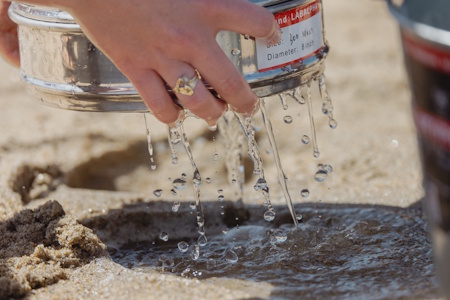
The collaboration extends across academia, government, and NGOs, with involvement from the California Marine Sanctuary Foundation, the Moore Institute for Plastic Pollution Research, the National Oceanic and Atmospheric Administration’s Monterey Bay National Marine Sanctuary, and Stanford. “We’re adding all these different skills together to study microplastics along the central California region,” Savoca said. More than 100 local volunteers have helped with sampling, he said. “We have so many people wanting to help with this issue. That’s been really inspiring.”
Where and how microplastics hide
The buoyancy of most plastics, which makes many of the microplastics at Savoca’s field site float in saltwater, is at the core of a mystery that other Stanford researchers are trying to crack about where plastics end up and how they get there.
“There’s a gap between how much plastic waste ends up in the ocean, and the relatively small amount of microplastics found floating on the ocean surface,” explained Jinliang Liu, a former researcher in Earth system science Professor Leif Thomas’s group at the Doerr School of Sustainability.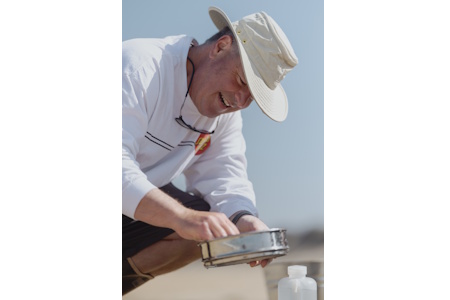
Liu and Thomas have set out to explain why so few microplastics remain at the surface. By integrating state-of-the-art ocean models with a microplastic transport model pioneered by Nan Wu at the British Antarctic Survey, they are simulating the physical and biological processes that bring microplastics to the deep ocean, especially in areas where converging ocean currents may cause plastics to accumulate.
The work could lead to insights about how microplastics affect marine life, ocean food webs and health, and even Earth’s carbon cycle. Some particles join with clusters of debris and microbes known as marine snow, which remove carbon dioxide from the atmosphere as they sink to the ocean floor or get eaten by deep-sea creatures.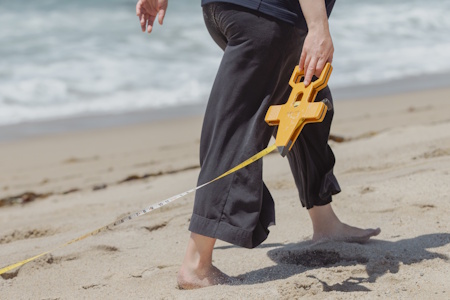
“Without any other influence, microplastics will just hang out on the ocean surface,” explained Liu. “Uncovering the reasons why it disappears from the surface is a crucial part of addressing this global environmental challenge.”
Over the past decade, Stanford bioengineering Professor Manu Prakash and his research team have been systematically sampling columns of ocean water around the world to measure carbon flux and sequestration. “More and more, in deeper water columns, we started seeing a lot more microplastics,” Prakash said.
Out of that creeping awareness grew an effort to map out the distribution of microplastic types and densities at depths down to a kilometer below the surface. “The biggest surprise for me has been the abundance,” Prakash said. “Every single drop I look at – every sample from an aquatic environment – has microplastic in it. The colors pop out under a scope unlike anything else.”
The team now cryopreserves microplastic samples collected at sea so that, back in the lab, they can genetically identify which microbial organisms are growing on the particles and begin to decipher how microbial communities, plastic type, and particle density correlate with sinking speed. “This is baseline work that we do, primarily to assess whether there are patterns,” Prakash said.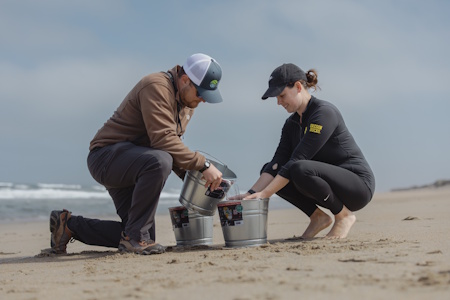
From sea to self
For Savoca, the fieldwork collecting microplastics from rivers and beaches is part of broader efforts to understand pollution and its consequences, and better ways forward. “I’m really interested in how ecosystems work, how they break, and if and how we should put them back together,” he explained.
Working in the lab of oceans Associate Professor Jeremy Goldbogen, Savoca has helped to quantify the staggering amount of plastic – up to 10 million pieces a day – that blue, fin, and humpback whales on the California coast ingest through their prey.
Other researchers have found that some microplastic particles make their way out of whales’ digestive system and into fat and liver tissue, where, as in our own bodies, scientists are only beginning to understand the risks. “This is not just an environmental health issue. It’s not just a wildlife health issue. It is most certainly a human health issue,” Savoca said.
Microplastics have been found across a variety of foods popular on American plates, including not only seafood but also poultry, beef, pork, and plant-based meat alternatives. “We already have warning flags about mercury in seafood and limiting intake because of that,” said Stephen Palumbi, the Jane and Marshall Steele Jr. Professor in Marine Sciences. “Will such warnings be needed about microplastics, too?”
Measuring (and reducing) the burden
In Stanford’s medical and engineering labs, Kara Meister, Prakash, and colleagues are pioneering a faster, easier way to detect and measure microplastics and even smaller nanoplastics in food, water, and human tissues and fluids. Supported by the Center for Human and Planetary Health and the Sustainability Accelerator at the Doerr School of Sustainability, the group aims to use this innovation to monitor micro- and nanoplastic levels in populations across California and around the world – and then correlate exposure with health data.
“We want to be able to really understand the current burden, and measure it over time,” said Meister, a pediatric otolaryngologist at Stanford Medicine whose lab studies how microplastics may influence children’s immune systems.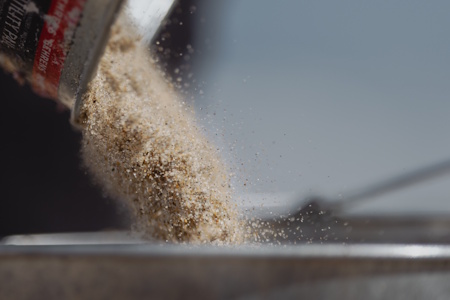
Existing techniques give doctors and researchers a fragmented view of microplastics, which come in a wide range of shapes and sizes, and often get bound up with proteins in human cells and other compounds such as dyes or plasticizers. Some methods identify polymer types, while others measure particle size or location in tissue.
"This is not just an environmental health issue. It’s not just a wildlife health issue. It is most certainly a human health issue." Matthew Savoca Research Scientist, Oceans Department, Stanford Doerr School of Sustainability
The new method being developed by Meister, Prakash, and collaborators, including Jennifer Dionne and Thomas Baer, sacrifices some precision for potentially broader reach, making it possible to find hidden patterns in massive datasets. “There is a lot of power in that kind of data, even if each individual measurement is not as precise,” Meister said.
The team is using a technique called Raman spectroscopy to identify polymer types. Commonly used to check for purity in drug manufacturing, the technique involves shining a laser beam onto a sample and then measuring shifts in the scattered light caused by molecular vibrations. Because it’s non-invasive – beams can harmlessly shine directly through the skin – some researchers see promise in the technique for a range of clinical applications, from measuring glucose to early cancer diagnosis. “If we are talking about tackling a problem in every corner of the world, we have to think about tools that scale to every corner of the world. Accessibility builds in scale,” Prakash said.
For microplastics, the Stanford team is studying the use of this technique for identifying and quantifying polymers alongside a range of methods for locating microplastics in tissue. Early progress includes confirming the presence of microplastics in pediatric tonsil samples and identifying plastic types in tonsil tissues artificially spiked with polymers in the lab.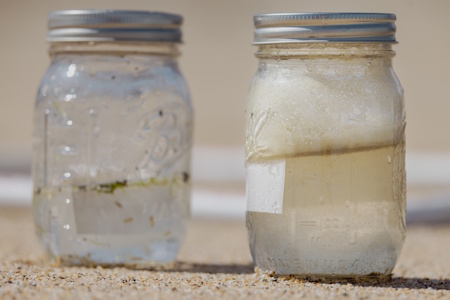
The health risks posed by microplastics may vary widely and depend on factors such as individual genetics and exposure to other materials in the environment. “But if we want to understand the biological implications of microplastics and their associated chemicals, we need precise measurements, ideally with human tissue,” Meister said.
For people looking to minimize their own exposure to microplastics, even as scientists work to understand how they move through and affect our bodies and world, experts say the most impactful step at an individual level is to reduce use of plastic packaging – especially single-use plastics that touch food and drinks.
“On a personal level, these changes make a difference,” said Amelia Meyer, an environmental scientist who co-leads the Plastics and Health Working Group at the Center for Human and Planetary Health. “But it’s also important to remember that microplastics are a systemic problem. The real solution lies in pushing for better regulations, safer materials, and less plastic pollution overall.”
Liu and Thomas’s project is supported by a Big Ideas for Oceans grant jointly awarded by the Oceans Department and the Woods Institute for the Environment at the Doerr School of Sustainability. Liu is now an assistant professor at Coastal Carolina University.
Thomas is a professor of Earth system science and (by courtesy) of oceans in the Doerr School of Sustainability. He is also a professor (by courtesy) of civil and environmental engineering, a joint department of the Doerr School of Sustainability and the School of Engineering.
Prakash is an associate professor of bioengineering, a department jointly supported by the School of Engineering and the School of Medicine, and (by courtesy) of oceans, and a senior fellow at the Woods Institute.
The Center for Human and Planetary Health is a joint effort of the Woods Institute at the Doerr School of Sustainability and the Center for Innovation in Global Health at the School of Medicine. The Human and Planetary Health grant awarded to Meister and colleagues was jointly awarded with the Woods Institute’s Environmental Venture Projects program.
Dionne is a professor of materials science and engineering in the School of Engineering and (by courtesy) of radiology in the Rad/Molecular Imaging Program at Stanford. She is a senior fellow at the Precourt Institute for Energy, part of the Doerr School of Sustainability. Baer is an adjunct professor of applied physics in the School of Humanities and Sciences and executive director of the Stanford Photonics Research Center.
Goldbogen is a professor of oceans in the Doerr School of Sustainability and (by courtesy) of biology in the School of Humanities and Sciences. Palumbi is a professor of oceans and of biology. Luthy is the Silas H. Palmer Professor of civil and environmental engineering and (by courtesy) of oceans. Micheli is the David and Lucile Packard Professor of Marine Science and a professor of oceans and (by courtesy) of biology. She is co-director of the Center for Ocean Solutions and a senior fellow at the Woods Institute.
Meyer is also a research program manager in the lab of Desiree LaBeaud, professor of pediatrics (infectious diseases) and (by courtesy) of epidemiology and population health at the School of Medicine and co-lead of the Plastics and Health Working Group. LaBeaud is also a senior fellow at the Woods Institute and professor (by courtesy) of environmental social sciences in the Doerr School of Sustainability.
Source: Stanford University
